Criminology Report: Victimization, Crime, and Community Policing
VerifiedAdded on 2022/10/17
|10
|605
|18
Report
AI Summary
This report delves into key aspects of criminology, examining the theory of victimization, which includes lifestyle and hate crimes. It also explores statistical data concerning crime rates among different ethnic groups, highlighting disparities and trends. Furthermore, the report discusses community policing, emphasizing its participatory approach to crime prevention, fostering cooperation, and building trust between minority groups and law enforcement. The report also highlights the importance of community policing in enhancing residents' sense of security and their satisfaction with police work, as well as its role in facilitating communication and crime prevention strategies within communities.
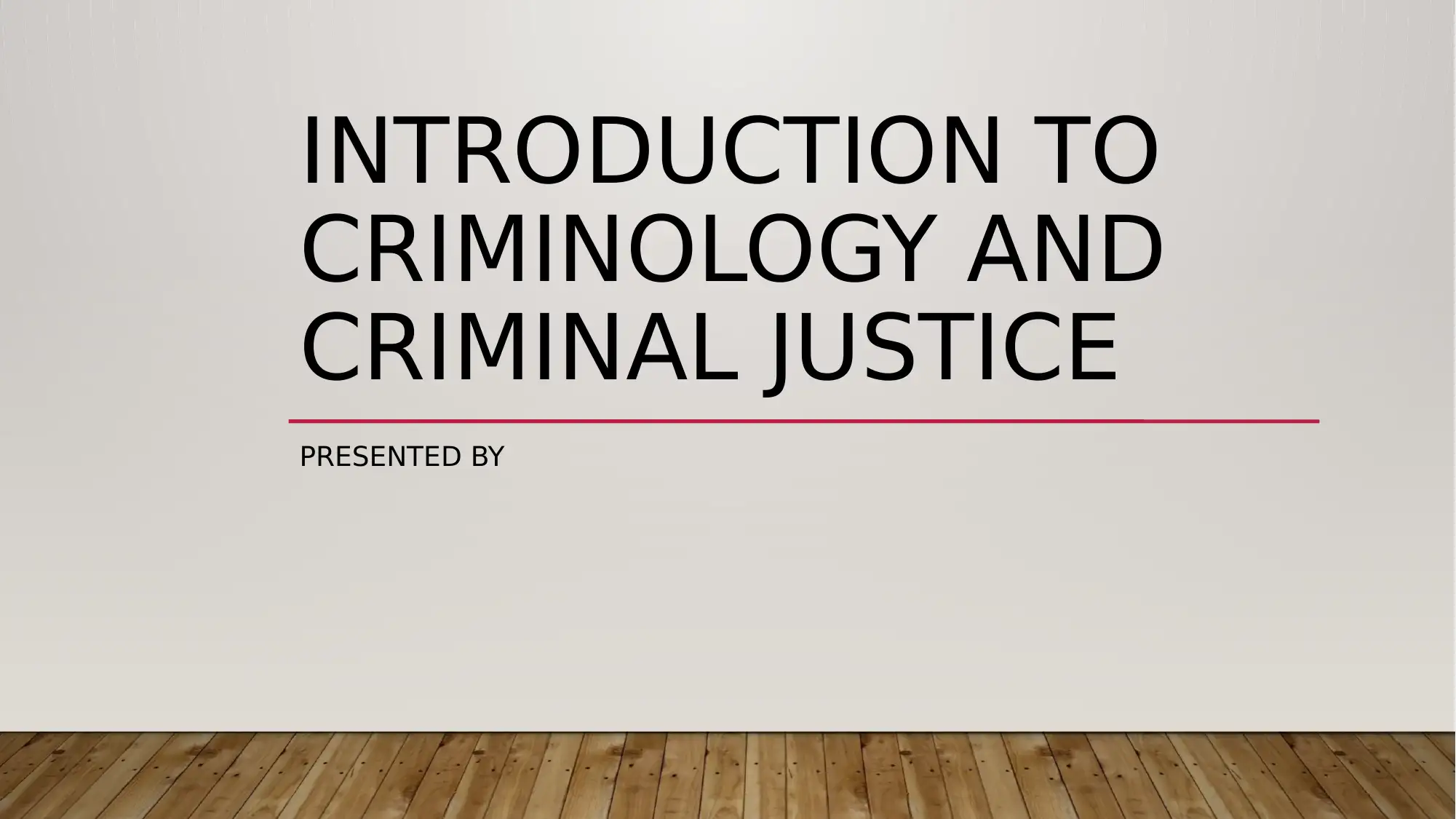
INTRODUCTION TO
CRIMINOLOGY AND
CRIMINAL JUSTICE
PRESENTED BY
CRIMINOLOGY AND
CRIMINAL JUSTICE
PRESENTED BY
Paraphrase This Document
Need a fresh take? Get an instant paraphrase of this document with our AI Paraphraser
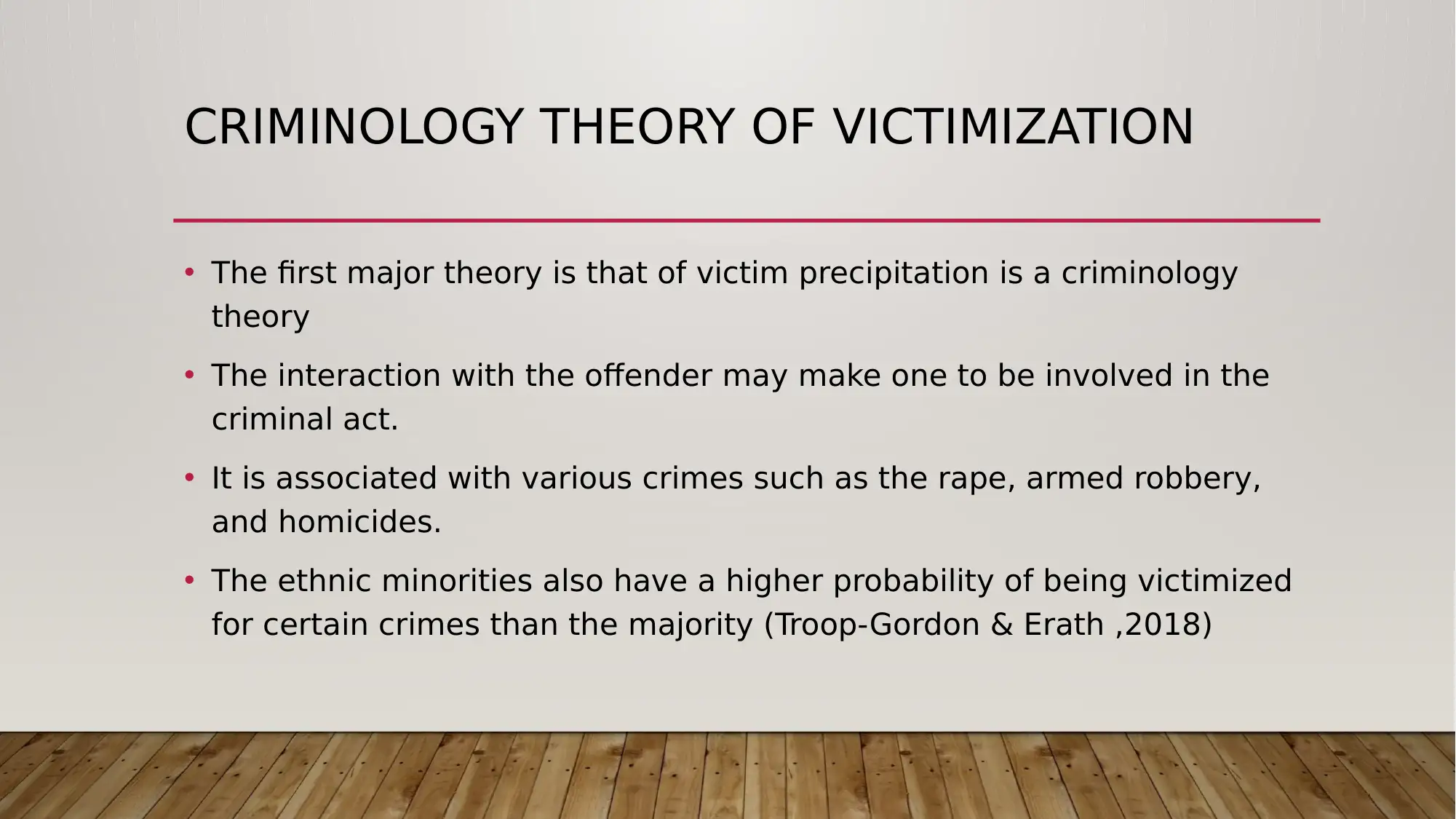
CRIMINOLOGY THEORY OF VICTIMIZATION
• The first major theory is that of victim precipitation is a criminology
theory
• The interaction with the offender may make one to be involved in the
criminal act.
• It is associated with various crimes such as the rape, armed robbery,
and homicides.
• The ethnic minorities also have a higher probability of being victimized
for certain crimes than the majority (Troop-Gordon & Erath ,2018)
• The first major theory is that of victim precipitation is a criminology
theory
• The interaction with the offender may make one to be involved in the
criminal act.
• It is associated with various crimes such as the rape, armed robbery,
and homicides.
• The ethnic minorities also have a higher probability of being victimized
for certain crimes than the majority (Troop-Gordon & Erath ,2018)
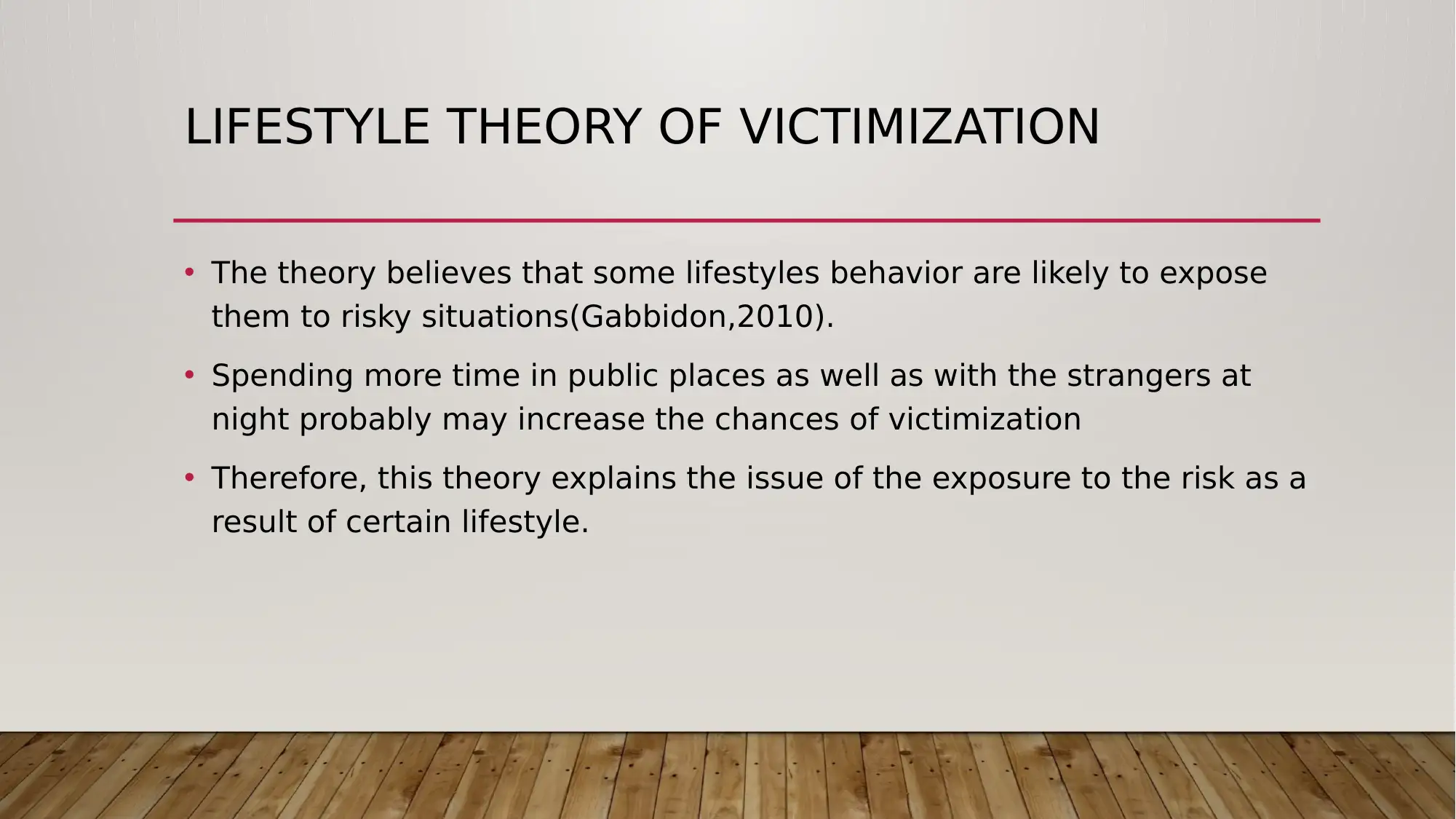
LIFESTYLE THEORY OF VICTIMIZATION
• The theory believes that some lifestyles behavior are likely to expose
them to risky situations(Gabbidon,2010).
• Spending more time in public places as well as with the strangers at
night probably may increase the chances of victimization
• Therefore, this theory explains the issue of the exposure to the risk as a
result of certain lifestyle.
• The theory believes that some lifestyles behavior are likely to expose
them to risky situations(Gabbidon,2010).
• Spending more time in public places as well as with the strangers at
night probably may increase the chances of victimization
• Therefore, this theory explains the issue of the exposure to the risk as a
result of certain lifestyle.
⊘ This is a preview!⊘
Do you want full access?
Subscribe today to unlock all pages.

Trusted by 1+ million students worldwide
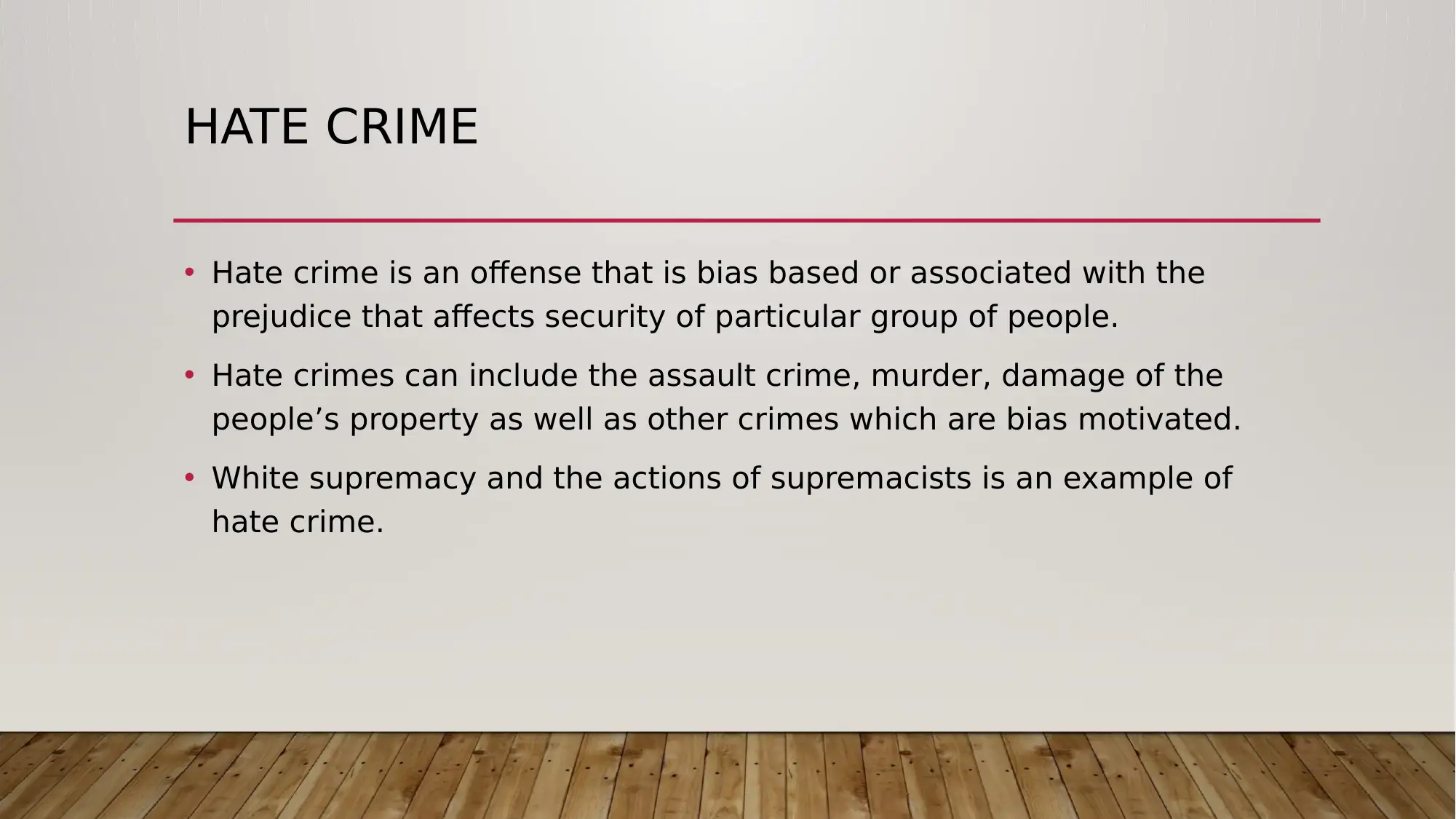
HATE CRIME
• Hate crime is an offense that is bias based or associated with the
prejudice that affects security of particular group of people.
• Hate crimes can include the assault crime, murder, damage of the
people’s property as well as other crimes which are bias motivated.
• White supremacy and the actions of supremacists is an example of
hate crime.
• Hate crime is an offense that is bias based or associated with the
prejudice that affects security of particular group of people.
• Hate crimes can include the assault crime, murder, damage of the
people’s property as well as other crimes which are bias motivated.
• White supremacy and the actions of supremacists is an example of
hate crime.
Paraphrase This Document
Need a fresh take? Get an instant paraphrase of this document with our AI Paraphraser
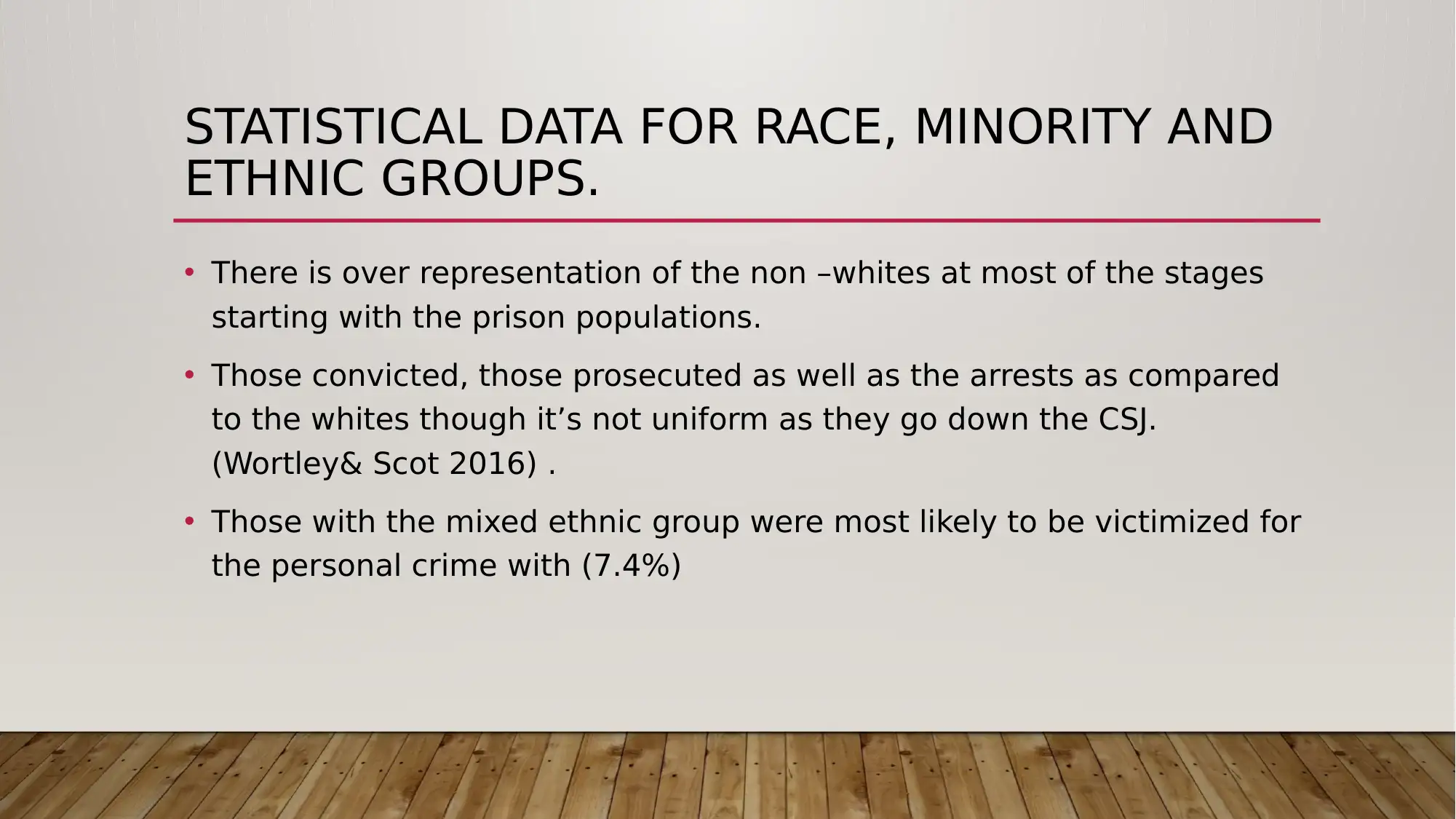
STATISTICAL DATA FOR RACE, MINORITY AND
ETHNIC GROUPS.
• There is over representation of the non –whites at most of the stages
starting with the prison populations.
• Those convicted, those prosecuted as well as the arrests as compared
to the whites though it’s not uniform as they go down the CSJ.
(Wortley& Scot 2016) .
• Those with the mixed ethnic group were most likely to be victimized for
the personal crime with (7.4%)
ETHNIC GROUPS.
• There is over representation of the non –whites at most of the stages
starting with the prison populations.
• Those convicted, those prosecuted as well as the arrests as compared
to the whites though it’s not uniform as they go down the CSJ.
(Wortley& Scot 2016) .
• Those with the mixed ethnic group were most likely to be victimized for
the personal crime with (7.4%)
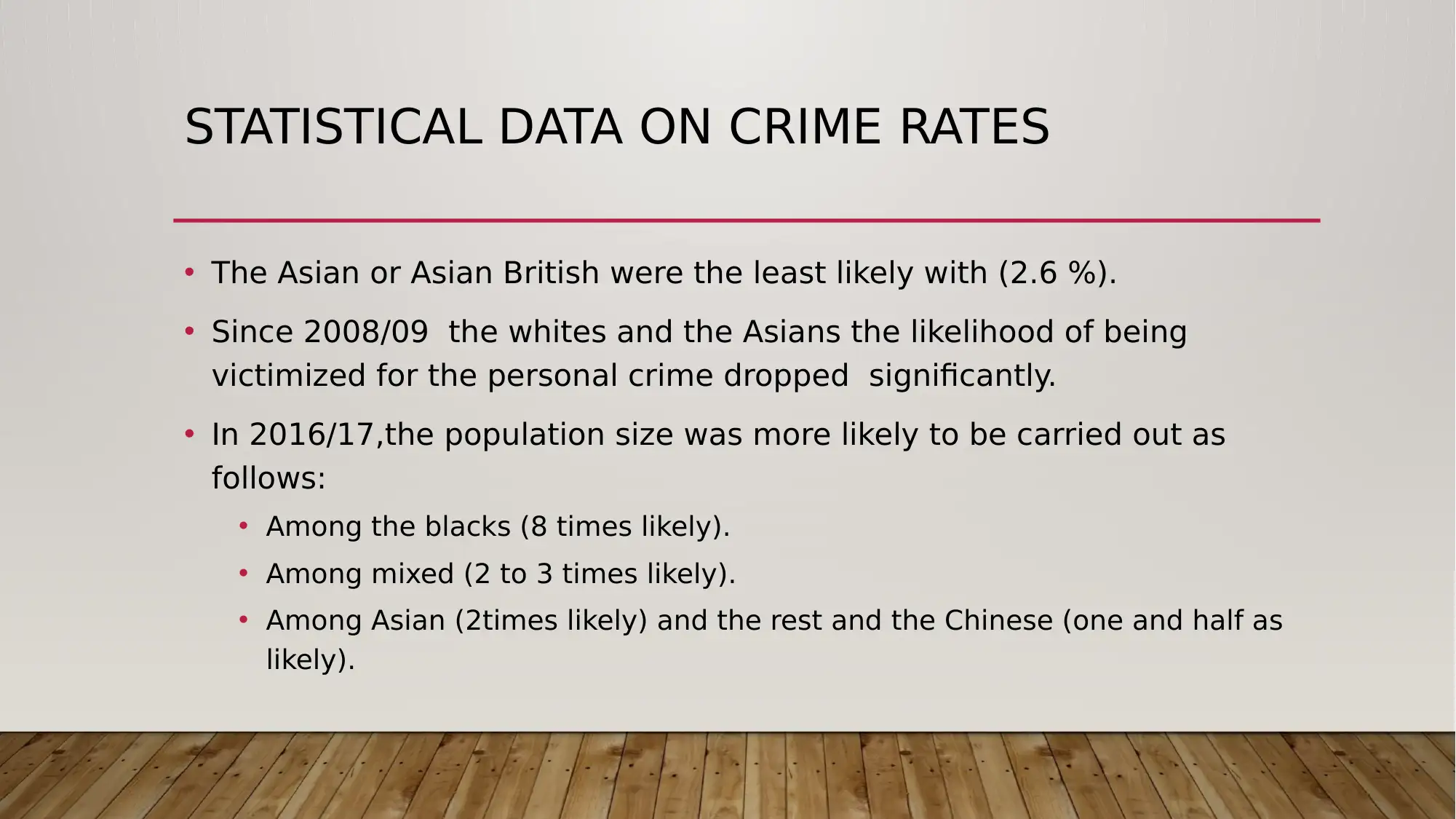
STATISTICAL DATA ON CRIME RATES
• The Asian or Asian British were the least likely with (2.6 %).
• Since 2008/09 the whites and the Asians the likelihood of being
victimized for the personal crime dropped significantly.
• In 2016/17,the population size was more likely to be carried out as
follows:
• Among the blacks (8 times likely).
• Among mixed (2 to 3 times likely).
• Among Asian (2times likely) and the rest and the Chinese (one and half as
likely).
• The Asian or Asian British were the least likely with (2.6 %).
• Since 2008/09 the whites and the Asians the likelihood of being
victimized for the personal crime dropped significantly.
• In 2016/17,the population size was more likely to be carried out as
follows:
• Among the blacks (8 times likely).
• Among mixed (2 to 3 times likely).
• Among Asian (2times likely) and the rest and the Chinese (one and half as
likely).
⊘ This is a preview!⊘
Do you want full access?
Subscribe today to unlock all pages.

Trusted by 1+ million students worldwide
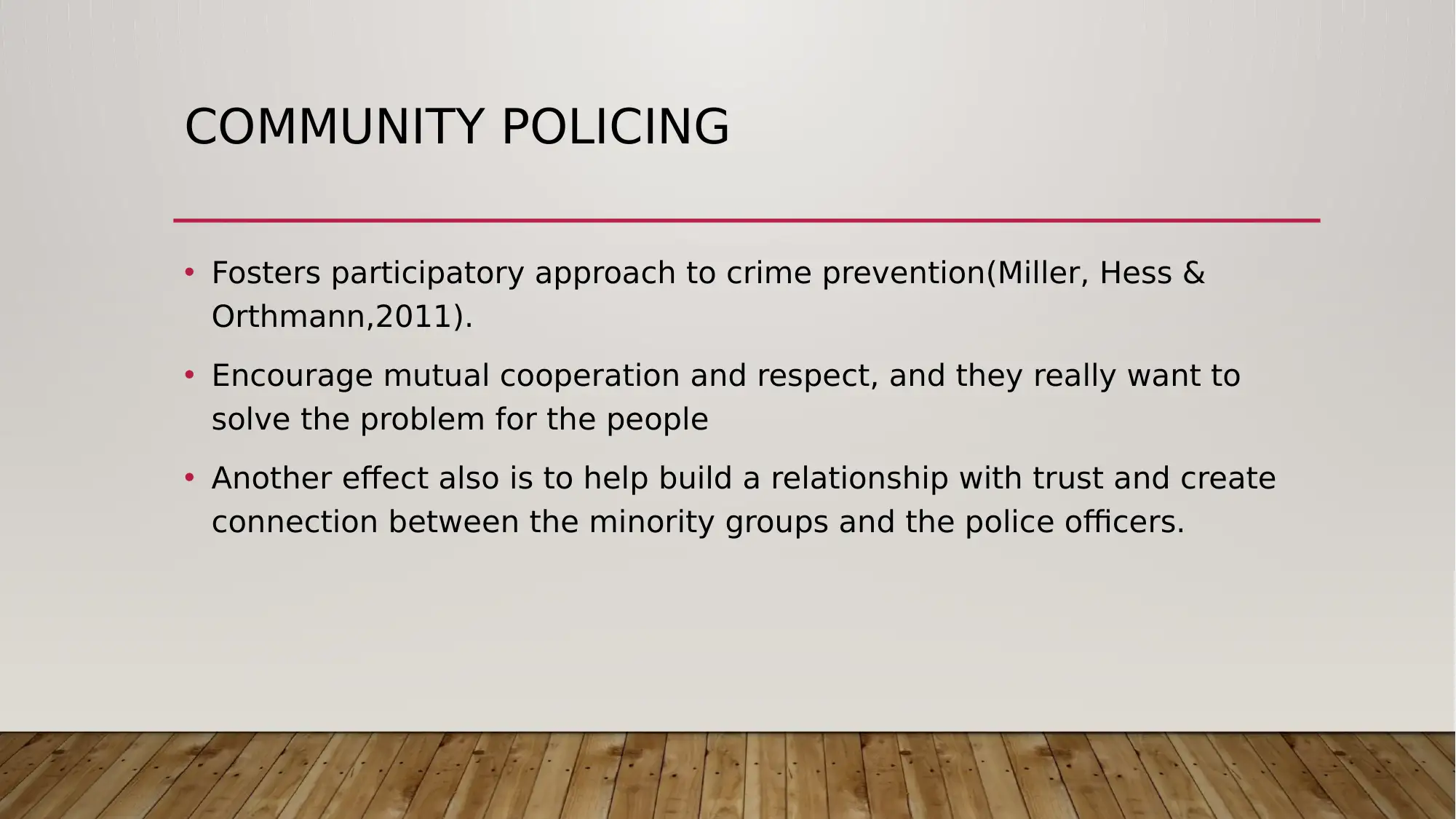
COMMUNITY POLICING
• Fosters participatory approach to crime prevention(Miller, Hess &
Orthmann,2011).
• Encourage mutual cooperation and respect, and they really want to
solve the problem for the people
• Another effect also is to help build a relationship with trust and create
connection between the minority groups and the police officers.
• Fosters participatory approach to crime prevention(Miller, Hess &
Orthmann,2011).
• Encourage mutual cooperation and respect, and they really want to
solve the problem for the people
• Another effect also is to help build a relationship with trust and create
connection between the minority groups and the police officers.
Paraphrase This Document
Need a fresh take? Get an instant paraphrase of this document with our AI Paraphraser
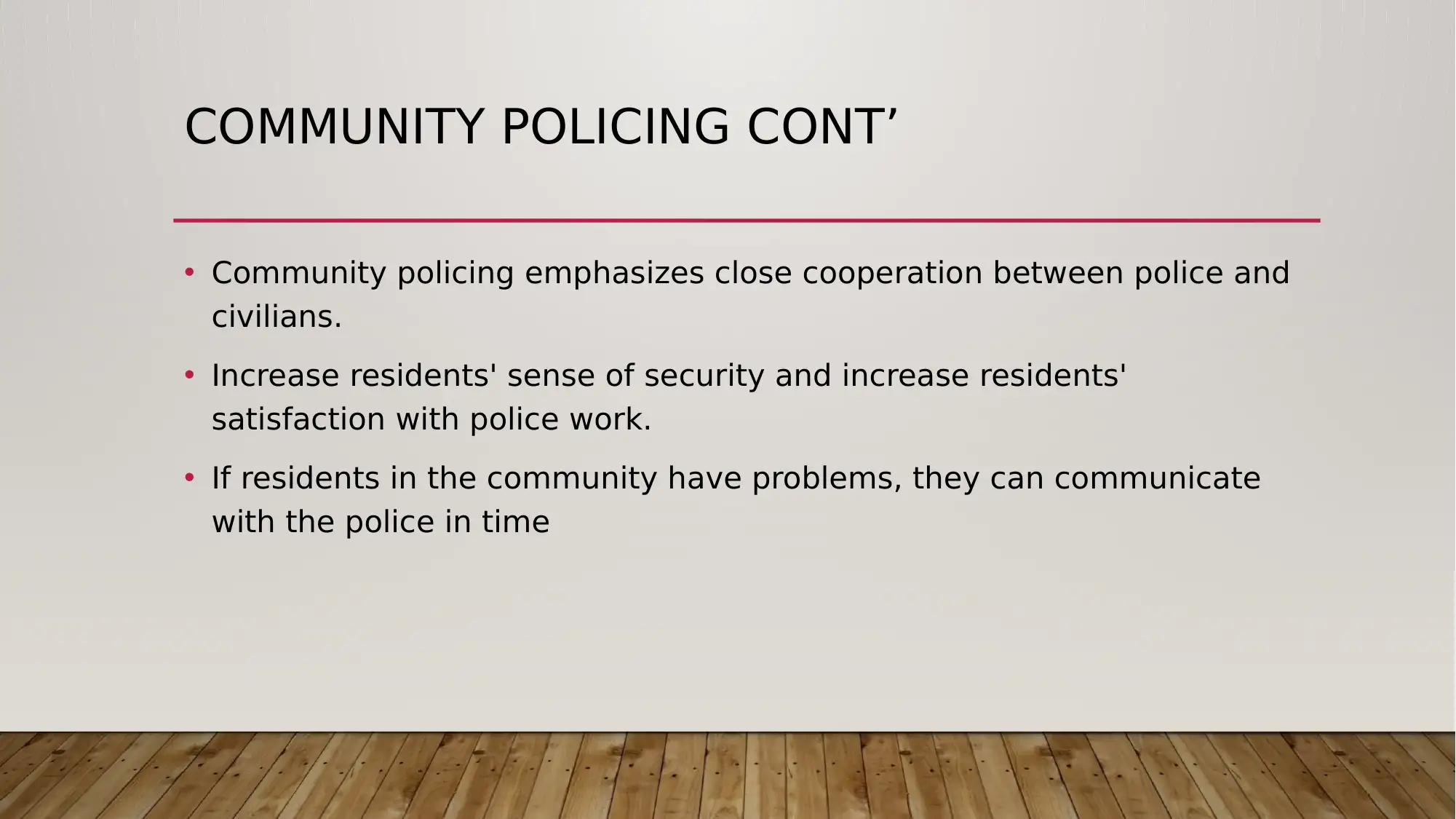
COMMUNITY POLICING CONT’
• Community policing emphasizes close cooperation between police and
civilians.
• Increase residents' sense of security and increase residents'
satisfaction with police work.
• If residents in the community have problems, they can communicate
with the police in time
• Community policing emphasizes close cooperation between police and
civilians.
• Increase residents' sense of security and increase residents'
satisfaction with police work.
• If residents in the community have problems, they can communicate
with the police in time
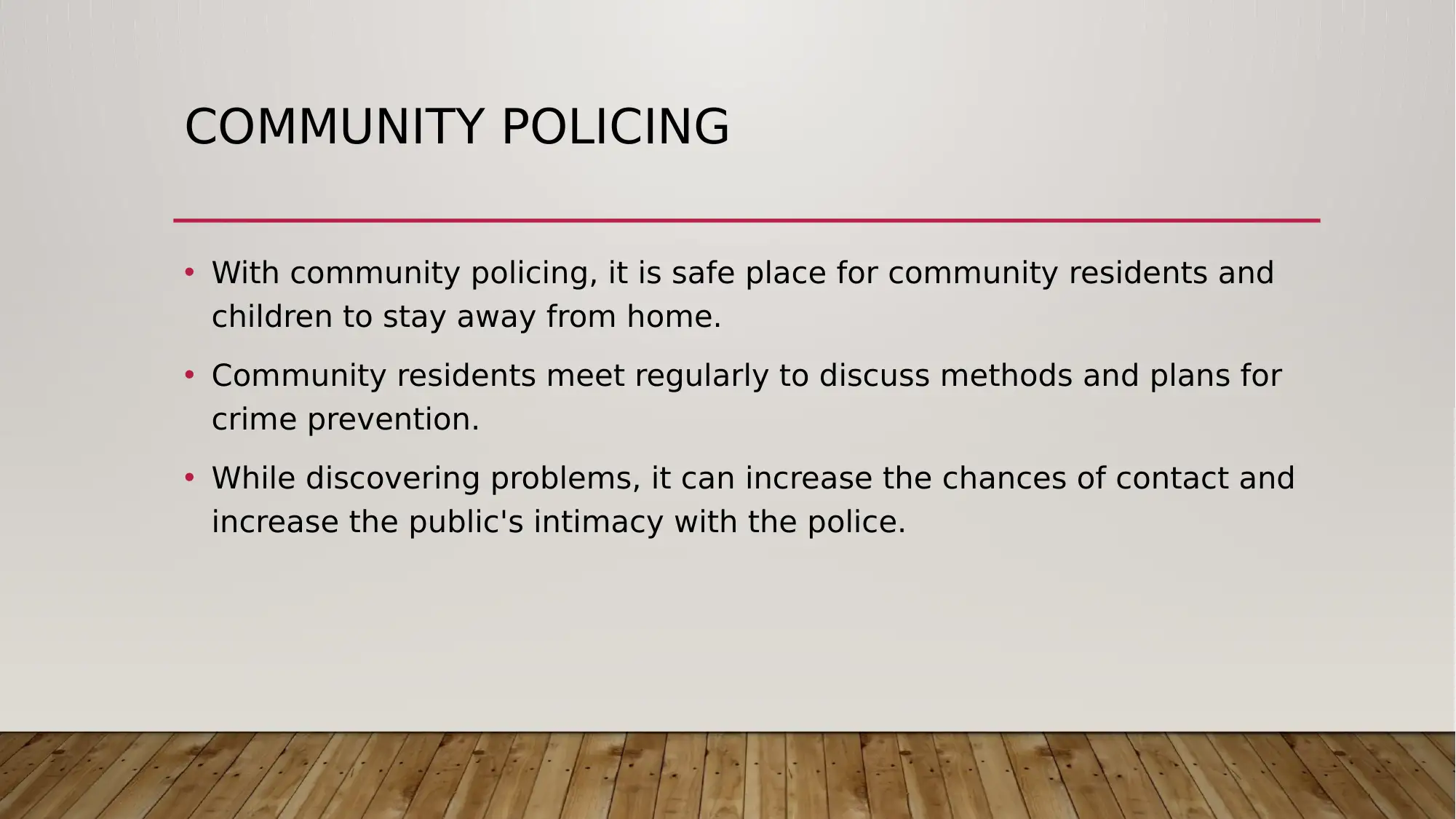
COMMUNITY POLICING
• With community policing, it is safe place for community residents and
children to stay away from home.
• Community residents meet regularly to discuss methods and plans for
crime prevention.
• While discovering problems, it can increase the chances of contact and
increase the public's intimacy with the police.
• With community policing, it is safe place for community residents and
children to stay away from home.
• Community residents meet regularly to discuss methods and plans for
crime prevention.
• While discovering problems, it can increase the chances of contact and
increase the public's intimacy with the police.
⊘ This is a preview!⊘
Do you want full access?
Subscribe today to unlock all pages.

Trusted by 1+ million students worldwide
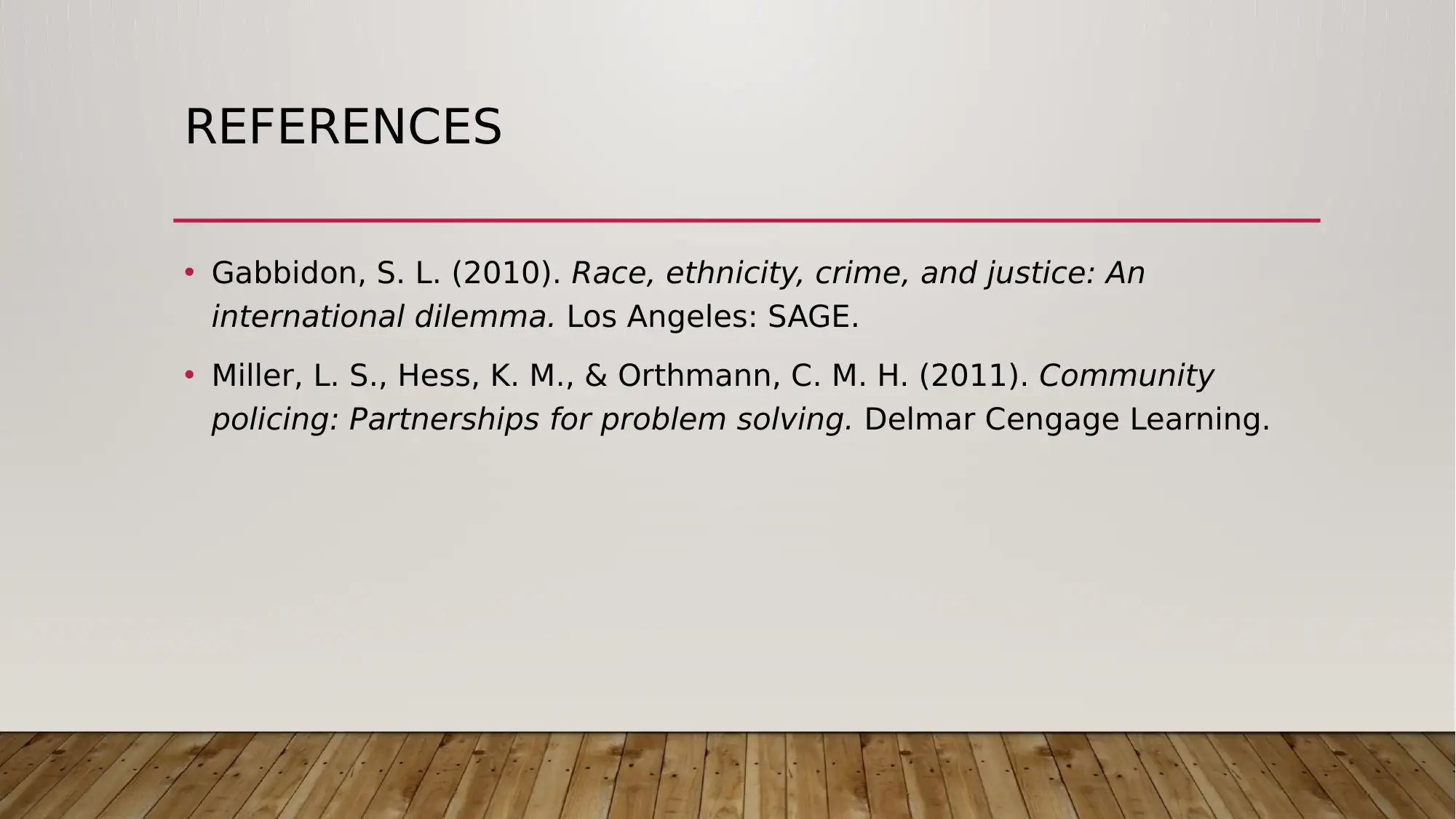
REFERENCES
• Gabbidon, S. L. (2010). Race, ethnicity, crime, and justice: An
international dilemma. Los Angeles: SAGE.
• Miller, L. S., Hess, K. M., & Orthmann, C. M. H. (2011). Community
policing: Partnerships for problem solving. Delmar Cengage Learning.
• Gabbidon, S. L. (2010). Race, ethnicity, crime, and justice: An
international dilemma. Los Angeles: SAGE.
• Miller, L. S., Hess, K. M., & Orthmann, C. M. H. (2011). Community
policing: Partnerships for problem solving. Delmar Cengage Learning.
1 out of 10
Related Documents
Your All-in-One AI-Powered Toolkit for Academic Success.
+13062052269
info@desklib.com
Available 24*7 on WhatsApp / Email
![[object Object]](/_next/static/media/star-bottom.7253800d.svg)
Unlock your academic potential
Copyright © 2020–2025 A2Z Services. All Rights Reserved. Developed and managed by ZUCOL.




